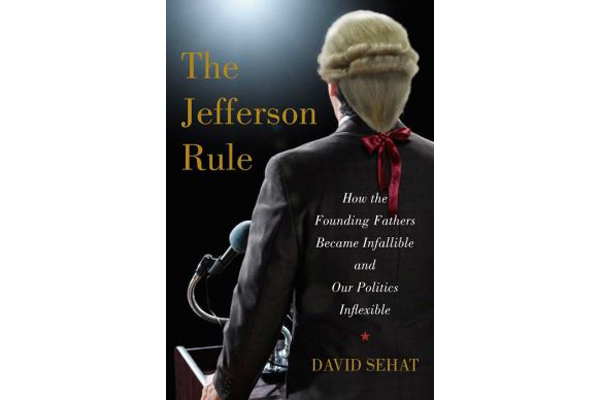Founding Troubles

What’s the harm in American politicians invoking the Founding Fathers and the nation’s seminal documents, the Declaration of Independence and the United States Constitution, to make their case to the voters? These last two are our secular scripture, after all, and Washington and Jefferson et al. are our civic prophets. Indeed, both Democrats and Tea Party Republicans embrace Thomas Jefferson with equal fervor, albeit with different motives.
Who can argue against pols being pols, or also-rans disguising their musk with essence de Jefferson? David Sehat, that’s who. In his second book the author makes a strong case that forefather worship has had a pernicious effect on our politics throughout American history. From the very beginning our leaders, starting with the Founding Fathers themselves, have wrapped themselves in founding mythology as a way to stigmatize their opponents as heretics. One does not compromise or make deals with heretics, of course.
The Jefferson Rule: Why We Think the Founding Fathers Have All the Answers could not be timelier. American presidential candidates (announced or otherwise) already have started jostling over who represents America and the principles upon which it was founded. Throwing his hat into the ring in late March, Texas Senator Ted Cruz pledged to “reclaim the Constitution,” as if someone had purloined it and taken it to an undisclosed location.
Sehat’s thesis is that politicians who douse their policies and arguments in civic theology are not only doing the nation a disservice, they also are likely distorting history to fit their own agendas. The Founding Fathers, it turns out, fought like cats and dogs too, and signers of the Constitution started arguing over its meaning almost before the ink was dry.
For example, Alexander Hamilton and James Madison worked together writing the Federalist Papers, which explained and touted the proposed Constitution to a wary public. Their collaboration may well have been the difference in getting 13 disparate states to ratify a new, improved, and more powerful union. But these two signers of the august, if sometimes vague document interpreted it quite differently once it was in force. The schism between Hamilton and his fellow travelers (who included George Washington) and Madison and Jefferson and their acolytes over the power and role of the federal government is at the root of much of the current ideological impasse in our nation’s capital.
Sehat points out that President George Washington grew weary of Secretary of State Jefferson’s polemics. Jefferson, a proponent of states’ rights and minimalist government, described his difference with fellow cabinet member Hamilton in overheated rhetoric that sounds very contemporary: He wrote that Hamilton’s plan “flowed from principles adverse to liberty, & was calculated to undermine and demolish the republic.” It was the continuation of politics as holy war.
Washington not only sided with Hamilton’s policies and interpretation of the Constitution more often than not, he connived to torpedo Jefferson’s chances of succeeding him. Sehat writes, “In March 1796, [Washington] decided to retire and informed his appointed successor, John Adams, of his plans. But he did not publically reveal his decision until September, which helped ensure Adam’s election.”
The “power to the states” party of Jefferson and Madison would eventually emerge triumphant from 1800 to 1824, but in governing they quite often waxed Hamiltonian. For example, Jefferson would stretch his hitherto literal interpretation of the Constitution to enable him to expedite the Louisiana Purchase. President Madison would change his mind about Hamilton’s national bank and was not shy about flexing federal muscle against unenthusiastic northern states after he launched America’s first foreign war. Hamilton wasn’t such a bad heretic after all.
Sehat takes the reader through an engaging and insightful survey course in American history, pointing out where he believes "founding fanaticism" crops up as the last refuge of politicians who can’t make a more rational or contemporary case for their beliefs. He notes that presidents of different parties, from Ulysses S. Grant and Theodore Roosevelt to Woodrow Wilson, disputed the notion that the Founding Fathers had all the answers. In his 1905 inaugural address, Roosevelt explained his belief in a more assertive federal government this way: “Our forefathers faced certain perils which we have outgrown. We now face other perils, the very existence of which it was impossible that they should foresee.”
If new problems require new solutions, it can also be argued that our forefathers weren’t always lucid and coherent in their proclamations, much less their actions. They were only human. A prime example is the fact that the Declaration of Independence states that “All men are created equal” while the Constitution as signed by our Founding Fathers identifies a slave as three-fifths of a person. This discrepancy would be debated for more than 87 years and would only be settled by a cataclysmic war.